 One of the most important ingredients in winemaking is yeast. Without yeast, the wine must will not undergo fermentation. During fermentation, wine yeast functions to convert the sugar in the wine must into alcohol and carbon dioxide. The interaction of the yeast with the wine must creates aromatic byproducts which, depending upon which yeast strain you use, will express different aromatic characteristics from wine to wine.
One of the most important ingredients in winemaking is yeast. Without yeast, the wine must will not undergo fermentation. During fermentation, wine yeast functions to convert the sugar in the wine must into alcohol and carbon dioxide. The interaction of the yeast with the wine must creates aromatic byproducts which, depending upon which yeast strain you use, will express different aromatic characteristics from wine to wine.
Most wines are made with the yeast species Saccharomyces cerevisiae, though the exact strain used varies widely. Depending upon what type of wine you’re creating, and what aromatic profile you’d like to achieve, you must select a specific strain of wine yeast in order to create your desired style of wine.
Once the yeast cells die, they sink to the bottom of the fermentation vessel. The dead yeast cells in combination with skin, seed, and pulp fragments form what is known as “lees”. The longer the wine is in contact with the lees, the more they contribute to the overall complexity and quality of the wine. This practice of leaving wine “on the lees” has been documented for generations, dating as far back as ancient Roman times. Presently, this practice of leaving wine on the lees is employed often in red wine making as well as Champagne or Sparkling wine making and occasionally white wine making.
One type of yeast that is undesirable in wine is Brettanomyces bruxellensis (a.k.a. “Brett”). Brett is responsible for economic hardships for many wineries due to the ability of this yeast to decrease wine quality. The presence of Brett in wines is somewhat controversial, as there are some individuals that believe Brett is beneficial (particularly with some dessert wines). In general, higher levels of Brett in wine results in poor wine quality, due to the yeast’s ability to produce ethyl phenol compounds that significantly contribute to “off” aromas in wine, including “barnyard” and “Band-Aid” aromas.
In order to avoid the wine yeast B. bruxellensis from infecting your homemade wine, a sterile working environment is key. Generally, Brett infections can be well controlled in a home winemaking environment through the simple use of sanitizers. Sodium metabisulfite and water being a common one. B. bruxellensis is naturally present everywhere (particularly in cellars) one must always take precautions and maintain a clean environment.
In general, if you’re following a wine recipe, pay close attention to which type of wine yeast the instructions call for. If you’re creating one of your own wine recipes, it’s very important that you do some research in order to determine exactly which strain of yeast will be optimal for the style of wine you’re trying to create. Finally, maintaining a sterile environment will help ensure that you don’t have any rogue infections from any other undesired yeasts in your wine.
———————————————————————————————————
Ed Kraus is a 3rd generation home brewer/winemaker and has been an owner of E. C. Kraus since 1999. He has been helping individuals make better wine and beer for over 25 years.
Category Archives: Wine
Part Of My Batch Of Wine Is Bland!
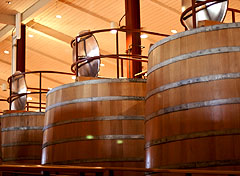 I made 25 gallons of yellow plum wine this summer (began in August 2012). One batch in one of the 5-gallon carboys looks and has the consistency of water (not very interesting) and appears to have finished all of its fermentation. I’ve calculated its alcohol content to be around 12%, but its bland, dry flavor suggests that I add sugar before bottling, but this doesn’t seem to help much when I add sugar syrup in a glass to taste. Can I add brandy to fortify it? How much or what would you add to a very dry, uninteresting wine like this? It hasn’t turned bad, it’s just poor quality.
I made 25 gallons of yellow plum wine this summer (began in August 2012). One batch in one of the 5-gallon carboys looks and has the consistency of water (not very interesting) and appears to have finished all of its fermentation. I’ve calculated its alcohol content to be around 12%, but its bland, dry flavor suggests that I add sugar before bottling, but this doesn’t seem to help much when I add sugar syrup in a glass to taste. Can I add brandy to fortify it? How much or what would you add to a very dry, uninteresting wine like this? It hasn’t turned bad, it’s just poor quality.
Name: Kathy
State: WA
Hello Kathy,
Thanks for the interesting question. I think that we can both agree that since these carboys of wine are all yellow plum, started at the same time, that some of the batch was not treat the same as the rest. Therefore, you have this one carboy that sticks out like a sore thumb.
From the symptoms you gave it sound like the particular carboy in question is lacking in body and flavor. This is caused by the fermentation not have enough contact with the pulp. This pulp is where the flavor and character of the wine comes from. Since this 5 gallons of wine is short on pulp, my guess is that you may have another carboy or two that is long on pulp.
With that said, there are two ways you can go about resolving this issue. Adding plum brandy is not one of them:
The first method is to cross-rack the 5 carboys of plum wine that you have. This is how a commercial winery would have handled it from the beginning. With each racking they would have gone from two carboys simultaneously into one carboy, and then another. By the time you get to the last racking, before bottling, the wine would be evenly blended. Since I assume that you have already done most of the rackings, this may not be a practical option for you at this time. It’s up to you as to whether or not you want to go through this process a couple of times. I you do decide to, I would urge you to make sure that your sulfite levels in the wine are correct after complete the blending.
The second method you could use is to treat the 5 gallons of wine in question and leave the others out of it. Adding brandy would not resolve the issue. While the additional flavor the brandy would add — particularly a plum brandy — would be great, the additional alcohol would make the wine too high in alcohol, or too hot. This additional alcohol would numb the tongue while drinking, giving the wine an even more watery impression.
Adding flavor is about your only option if you choose to take this route. I would suggest using one of our liqueur flavorings. These have been used successfully by many winemakers to enhance their wines. They come in many, many flavors and are very, very strong. One bottle per 5 gallons is the most I would recommend using.
Best Wishes,
Ed Kraus
———————————————————————————————————
Ed Kraus is a 3rd generation home brewer/winemaker and has been an owner of E. C. Kraus since 1999. He has been helping individuals make better wine and beer for over 25 years.
How Do I Get The Wine From The Sediment?
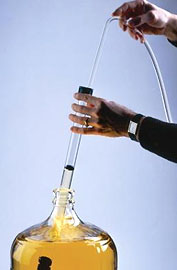 I used too much Speedy Bentonite to clear my last batch of wine. The bentonite worked, but there is a bunch of sediment. I racked off the wine that was clear. It tasted fine. There is about a gallon and a half of sediment. Will the bentonite continue to settle and is it worth the time and trouble for a few extra bottles
I used too much Speedy Bentonite to clear my last batch of wine. The bentonite worked, but there is a bunch of sediment. I racked off the wine that was clear. It tasted fine. There is about a gallon and a half of sediment. Will the bentonite continue to settle and is it worth the time and trouble for a few extra bottles
Name: Hans Wikle
State: WV
Hello Hans,
The general rule-of-thumb is to always get as much liquid as you can when you rack (siphon) your wine, even if it comes along with some sediment. It is only during your last racking, before bottling, that you need to be concerned with leaving all the sediment behind. By the time you get to that part of the process there will be little more than a dusting of sediment to avoid.
If you use this approach what you will discover is that your homemade wine will be just as clear when it comes time to bottle, and you will have much less loss of wine. This is true whether or not you add Bentonite to the wine.
You said you have already racked the wine, so I am assuming that you have a fermenter with this sediment and liquid in the bottom. Go ahead and try to get the liquid out and add it to your new fermenter that you just racked into. In the future, when your rack your wine, don’t stop when you get to the sediment, just keep going until you have all the liquid.
One item you may want to consider purchasing is a racking cane. It is basically a piece of clear rigid tubing that you slip onto the end of your siphon hose. Not only will it help you to direct where your siphon is pulling from (like a wand), it also comes with a diversion cap on the very tip of the wand. This keeps your from accidentally digging the racking cane into the packed sediment and drawing it. These racking canes come on all different lengths and have a curve at the top-end so that you do not have to worry about your siphon hose crimping as it comes out of the fermenter.
Best Wishes,
Ed Kraus
———————————————————————————————————
Ed Kraus is a 3rd generation home brewer/winemaker and has been an owner of E. C. Kraus since 1999. He has been helping individuals make better wine and beer for over 25 years.
Getting The Wine In The Bottle…
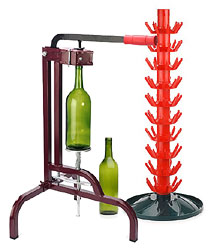 There are many steps to home winemaking, and each individual step is critical in maintaining the quality and acceptability of your homemade wine. First, you have to prepare the must either from juice or the fruit itself. Next, the must undergoes fermentation to convert the sugar in the must to alcohol. Further racking, clarifying, stabilizing, and aging steps help develop the wine to an even greater quality. Once you’ve past these steps, you may think you’re in the clear; however, bottling homemade wine is just as important as any one of the previous steps for maintaining homemade wine quality.
There are many steps to home winemaking, and each individual step is critical in maintaining the quality and acceptability of your homemade wine. First, you have to prepare the must either from juice or the fruit itself. Next, the must undergoes fermentation to convert the sugar in the must to alcohol. Further racking, clarifying, stabilizing, and aging steps help develop the wine to an even greater quality. Once you’ve past these steps, you may think you’re in the clear; however, bottling homemade wine is just as important as any one of the previous steps for maintaining homemade wine quality.
The first thing you need to do prior to bottling homemade wine is to prepare the wine bottles. You need to be sure the wine bottles you use are clean, not cracked or chipped, and free from all labels. If you recycle old bottles, remove the labels thoroughly by soaking in hot water and cleaner designed to clean winemaking equipment. For drying many bottles at once, it would be wise to invest in a bottle tree: they are great for drying and storing bottles while you wait to use them for bottling homemade wine.
The next step in bottling homemade wine is to prepare the wine bottle corks. You’ll need to decide if you would like to use natural cork or synthetic cork, though the use of synthetic cork is becoming more and more popular for bottling homemade wine in recent years.
To get the wine into your bottles, you may either pour directly from the spout on your storage container, or if you have a lot of wine to bottle or you’d like to get the process of bottling homemade wine done faster, a bottle filler is a great investment. This device allows you to fill multiple bottles at once, thus increasing your output and significantly reducing your bottling time.
The final step in bottling homemade wine is sealing them with corks. There are a lot great pieces of equipment out there that will help you in the process, as no one is strong enough to push a cork into a bottle of wine with just their bare hands. There are several different styles of corkers, from smaller hand-held devices or mid-sized bench top devices for small to medium quantities of wine, to larger floor corkers that are better for larger quantities of wine.
Whichever method you choose, bottling homemade wine is a step that is critical in ensuring and sealing in the quality of the wine while in storage.
———————————————————————————————————
Ed Kraus is a 3rd generation home brewer/winemaker and has been an owner of E. C. Kraus since 1999. He has been helping individuals make better wine and beer for over 25 years.
Can I Sanitize My Wine Bottles With Hydrogen Peroxide?
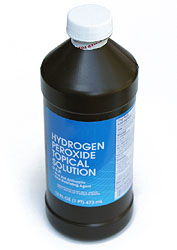 Ed,
Ed,
I rinsed my bottles with a mild solution of hot water and hydrogen peroxide. could this hurt the wine when it is bottled??.
Name: Butch Bellas
State: PA
Hello Butch,
Using hydrogen peroxide in hot water as a rinse for your wine bottles will not hurt the wine in any way, but it should be pointed out that this is not an effective sanitizer. If your purpose is to sanitize the wine bottles, then you need to do something completely different.
If using hydrogen peroxide as a sanitizer it needs to be used as a 3% solution. This is the strength you will find it on the store shelf. When you dilute it with water you are making it too weak to do any good. It needs to be used straight out of the bottle to sanitize. As you can start to imagine this can be cost prohibitive.
A better and cheaper way to sanitize wine bottles is to use one of the many sanitizers we offer. The three most popular are PBW, StarSan, and Easy Clean. If used as direct there is no question that your wine bottles will get completely sanitized.
Any of these sanitizers can also be used to sanitize your equipment or or anything else your wine or beer comes in contact with. This will help to insure that you never have to experience a spoiled batch.
Best Wishes,
Ed Kraus
———————————————————————————————————
Ed Kraus is a 3rd generation home brewer/winemaker and has been an owner of E. C. Kraus since 1999. He has been helping individuals make better wine and beer for over 25 years.
My Persimmon Wine Won't Clear!
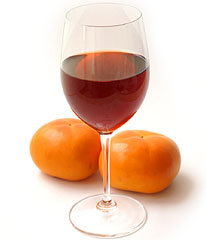 I have been making wine for over a year and lately have had no trouble clearing the wines. I started a 6 gallon batch of persimmon wine 1st Nov. According to our wine recipe it should be ready to bottle in the next week but it is still not clear. I have used several clearing agents. Will it clear if I just leave it for an extended period of time? I am going to rack it again. There is a lot of sediment in the bottom of the carboy. I have heard of people making persimmon wine so since I got the persimmons free I wanted to try it. Have you heard from anyone who has made persimmon wine.
I have been making wine for over a year and lately have had no trouble clearing the wines. I started a 6 gallon batch of persimmon wine 1st Nov. According to our wine recipe it should be ready to bottle in the next week but it is still not clear. I have used several clearing agents. Will it clear if I just leave it for an extended period of time? I am going to rack it again. There is a lot of sediment in the bottom of the carboy. I have heard of people making persimmon wine so since I got the persimmons free I wanted to try it. Have you heard from anyone who has made persimmon wine.
Name: Sandra Fey
State: Ky
Hello Sandra,
Thank you for the great question, and yes, I have heard of people making persimmon wine. I have never made it myself, but have partaken in it more than once.
There are a couple of things that could be going on with your wine. The first is that it may still be fermenting, only very slowly. It is not uncommon for a fermentation to drag on for extended periods of time when cooler weather comes upon us. Wine yeast are very sensitive to temperature. If your wine is in the 60’s, instead of the 70’s this could be your issue.
Fortunately, it is very easy to determine if temperature is the culprit. Simply take a hydrometer reading. If you are not getting a specific gravity reading of .998 or less, then the fermentation is not done. If you don’t have a gravity hydrometer, I would strongly urge you to get one. It is the most valuable tool you could have as a home winemaker.
If you discover that the temperature is the issue, the remedy is simple: warm the wine must up. You will see the fermentation become more active so that it can finish up and then clear up!
This second and more serious problem could be your wine has developed a pectin haze. Persimmons have a lot of pectin in them. Pectin is the gelatinous stuff that holds together the fruit fiber. It’s the stuff that allows you to make jellies and jams out of fruit. All good for toast but bad for making wine. If the pectin is not broken down during the fermentation your wine can develop a pectin haze.
This is why most wine recipes will call for pectic enzyme. This will help to break-down the pectin and eliminate the chance of a pectin haze. If you did not use pectic enzyme, or if the pectic enzyme you have is old, than this could definitely be your problem.
One way to test for this is to take a small sample of the wine and add teaspoon of pectic enzyme to it and let sit overnight. It the sample clears without causing any sediment, then a pectin haze is your problem. The only possible way to solve this problem would be with a double-dose of pectic enzyme and patience. Many times the wine will clear up with this treatment within a few weeks, but unfortunately, there are some wines that will never clear.
I hope this helps you out, Sandra,
Ed Kraus
———————————————————————————————————
Ed Kraus is a 3rd generation home brewer/winemaker and has been an owner of E. C. Kraus since 1999. He has been helping individuals make better wine and beer for over 25 years.
How Can I Make Organic Wine From Your Wine Kits?
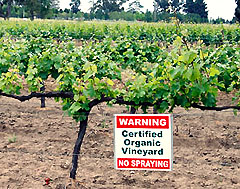 What would I have to eliminate in my wine kit (Cabernet Sauvignon ) to get close to an organic wine without sacrifice taste.
What would I have to eliminate in my wine kit (Cabernet Sauvignon ) to get close to an organic wine without sacrifice taste.
Thank you, Daniel
Name: Daniel B.
State: FL
Hello Daniel,
The whole idea behind organic wine is to grow the grapes without the use of pesticides or other manmade interferences — to keep the growth of the grapes as natural a possible. Unfortunately, we have never seen this type of packaged product made available to the home wine making market.
Most “organic” wines on the market contain sulfites, just like the potassium metabisulfite you will find in the wine ingredient kits we offer., but there are a handful of wineries that do not add sulfites to there wines out of principal.
The reason most organic wineries add sulfites is because the risk of spoilage is so high when they are not. Extreme care has to be taken to insure that the wine is not exposed to airborne contaminants, etc. Everything that come in contact with the wine has to be sanitized to a very high standard. All this takes time and money, and if spoilage does occur, it is usually the entire batch that is lost, not just some. A vineyard can only provide one harvest per year.
For the home winemaker, keeping spoilage from occurring is even harder than it is for the wineries. This is because the smaller batch size that most home winemakers are dealing with. A smaller batch has more surface contact with equipment on a per gallon then a large batch. This is just laws a physics. This extra surface contact per gallon increases the risk of spoilage proportionally. This is why it is so important for the home winemaker to use sulfites in their wine just has 99% of the commercial wineries do.
So to answer your question, regardless of what you leave out of the wine it still would not be consider “organic”, and to leave out the potassium metabisulfite is not practical anyway for the home winemaker.
I hope this helps you out.
Happy Winemaking,
Ed Kraus
———————————————————————————————————
Ed Kraus is a 3rd generation home brewer/winemaker and has been an owner of E. C. Kraus since 1999. He has been helping individuals make better wine and beer for over 25 years.
How Can I Make My Wine Sweeter?
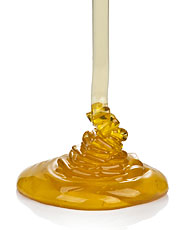 I have used 3 fruit base kits and keep getting a very dry high alcohol content wine. How can I make my wine sweeter.
I have used 3 fruit base kits and keep getting a very dry high alcohol content wine. How can I make my wine sweeter.
Name: Jerrie C.
State: AR
Hello Jerrie,
If you are getting more alcohol than you like in your wines, then you might want to use a wine hydrometer to start controlling your alcohol level. By using the wine hydrometer you can determine how much sugar you need to add to a wine must to get the final alcohol level you want. This assumes that all of the sugar will go towards the alcohol during the fermentation leaving you with a dry wine.
Once the fermentation has completed and the wine has had plenty of time to clear, that is the time to adjust the wines sweetness if desired. Add sugar to taste. It is important to understand that the wine needs plenty of time to clear before sweetening.
We recommend making a sugar syrup comprised of 1 part sugar and 1-2 parts water. Heat on the stove until it the syrup turns clear, and then allow to cool.
Once you have the wine to the sweetness you like it is important that you also add Potassium Sorbate. This is a wine stabilizer that will help to keep your wine from starting a re-fermentation with the new sugars.
To sum up, the sugar you are adding at the beginning of fermentation with the aid of a hydrometer is all contributing to the wine’s alcohol level. The sugar you add after fermentation is contributing to the wine’s sweetness. By handling it in this way, you have complete control of both aspects of your wine.
Happy Wine Making,
Ed Kraus
———————————————————————————————————
Ed Kraus is a 3rd generation home brewer/winemaker and has been an owner of E. C. Kraus since 1999. He has been helping individuals make better wine and beer for over 25 years.
How Do You Recycle Synthetic Corks?
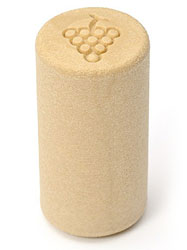 You said “Finally, synthetic corks are recyclable”. Question is how do I recycle corks? Do they go in with recyclables like plastic bottles?
You said “Finally, synthetic corks are recyclable”. Question is how do I recycle corks? Do they go in with recyclables like plastic bottles?
Sal
Name: Sal Runfola
State: NJ
Hello Sal,
Synthetic corks are not marked with a recyling number, but they are made of #7 plastic. Any recycling center that takes this plastic should be able to handle them just fine. If you are having trouble finding a location, go to https://search.earth911.com/ Type in “#7 Plastic Bottle” and your zipcode to find a location near you.
Happy Winemaking,
Ed Kraus
———————————————————————————————————
Ed Kraus is a 3rd generation home brewer/winemaker and has been an owner of E. C. Kraus since 1999. He has been helping individuals make better wine and beer for over 25 years.
My Wine Exploded!
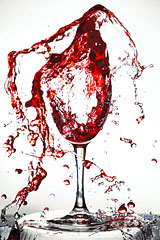 I racked my wine after sweetening it back let it set for a week to make sure the fermenting had stopped, took my reading which was ok. bottled it, and in about a week it started to explode. I’ve been making wine for 8 years and this is the first time this has happen. What caused this to occur?
I racked my wine after sweetening it back let it set for a week to make sure the fermenting had stopped, took my reading which was ok. bottled it, and in about a week it started to explode. I’ve been making wine for 8 years and this is the first time this has happen. What caused this to occur?
Name: Barbara E.
State: MS
Hello Barbara,
What has happened is somewhat straight-forward. The most common reason for a fermentation to stop is because it ran out of sugar to ferment. The fermentation is all about taking wine yeast consuming the sugars and converting them into alcohol and CO2 gas. If you add more sugar back to the wine, for whatever reason, the fermentation can start up again.
It only takes the slightest amount of fermentation to create a lot of CO2 gas and pressure. The pressure builds up and either pops the cork, or what happens in the case of screw-cap bottles, the bottle fails. This is what happened in your cause. The fact that you have not had this problem before in 8 years I find remarkable.
For future batches you can do just as you have done before. That is: let the fermentation complete and clear; then add sugar to taste at bottling time. But before bottling also add Potassium Sorbate. This is a wine stabilizer that will help keep the wine from re-fermenting. It is also important that the wine be given plenty of time to drop out all the inactive wine yeast after the fermentation before you sweeten and bottle. This will also help to keep a re-fermentation out of your future.
Best Wishes,
Ed Kraus
———————————————————————————————————
Ed Kraus is a 3rd generation home brewer/winemaker and has been an owner of E. C. Kraus since 1999. He has been helping individuals make better wine and beer for over 25 years.
